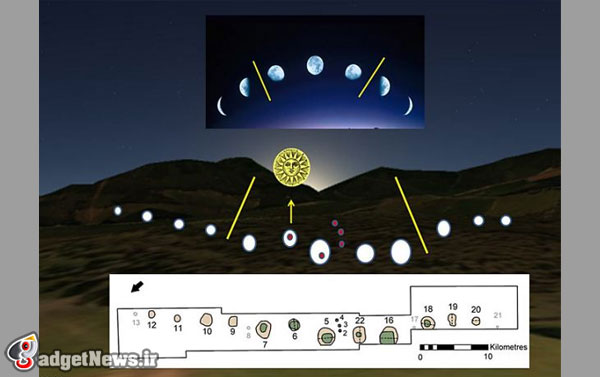
این تقویم باستانی شگفت انگیز از 12 حفره مختلف تشکیل شده که حالات مختلف ماه در آن نقش بسته است. با استفاده از این حفرهها، شهروندانی که از این تقویم استفاده کردهاند، میتوانستند ماههای قمری را شناسایی نمایند. پیش از کشف این تقویم، تصور میشد که قدیمیترین تقویم ساخت بشر متعلق به 5000 سال پیش است.
باستان شناسان معتقدند که موفق به کشف قدیمیترین تقویم جهان در حوالی اسکاتلند شدهاند.دوازده حفره گوناگون بر روی این تقویم باستانی وجود دارند که هر کدام به شکل کره ماه در زمانهای گوناگون سال میباشند. این حفرهها به مردم این امکان را میدادهاند تا با مشاهده ماه در آسمان و تطبیق دادن آن با شکل موجود در حفره، بتوانند ماه دقیق را تشخیص دهند.
محققان دانشگاه بیرمنگام اکنون باور دارند که قدمت این تقویم دو برابر بیشتر از قدیمیترین تقویم کشف شده در جهان است، که چیزی حدود 5000 سال قدمت دارد.تا پیش از این کشف ارزشمند، تصور میشد که اولین وسیله ساخته شده توسط بشر که برای اندازه گیری زمان مورد استفاده قرار میگرفته است، متعلق به تمدن بینالنهرین در 5000 سال گذشته بوده است.

تقویم باستانی کشف شده در «وارن فیلد» اسکاتلند، متعلق به دوران میانسنگی، یعنی حدودا 10,000 سال پیش است، و توسط اقوام آن دوره ساخته شده است.این تقویم بین سالهای 2004 تا 2006 میلادی کشف شده و نتایج تحلیل و بررسی آن، اکنون به صورت جامع توسط محققان دانشگاه بیرمنگام منتشر شده است.
مدیریت تیم تحقیقاتی این پروژه بر عهده پروفسور «وینس گافنی»، استاد باستانشناسی در دانشگاه بیرمنگام میباشد.این تقویم ترکیبی از تقویمهای شمسی و قمری میباشد.این کشف، دستاورد بزرگی برای شناخت هرچه بیشتر گذشته انسان است. اکنون دیگر میدانیم که حتی 10,000 سال قبل نیز تمدنهایی وجود داشتهاند که کارهایی مانند اندازه گیری زمان و تفکیک فصول برایشان اهمیت داشته و حتی تقویم مخصوص به خود داشتهاند.
منبع : dailymail
World's oldest calendar dating back more than 10,000 years discovered in Scotland
Archaeologists believe they have discovered the world's oldest 'calendar' in a field in Scotland.
A group of 12 pits recently excavated in Aberdeenshire appear to mimic and align with the phases of the moon, making it possible to track lunar months over the course of a year.
Researchers from the University of Birmingham now believe that the monument dates back 10,000 years – predating the earliest known calendar by 5,000 years.
The first formal time-measuring devices were thought to have been created in Mesopotamia about 5,000 years ago.
The pit alignment near Crathes Castle predates those discoveries by thousands of years, experts say.
The Mesolithic monument at Warren Field is said to have been created by hunter-gatherer societies nearly 10,000 years ago.
It was excavated between 2004 and 2006 and was recently analysed by researchers from the University of Birmingham.
They found that the monument pits align during the Midwinter sunrise, which researchers say would provide an annual 'astronomic correction' to maintain the link between the passage of time indicated by the moon, the solar year and the seasons.
The project was led by Vince Gaffney, professor of landscape archaeology at the University of Birmingham.
He said: 'The evidence suggests that hunter-gatherer societies in Scotland had both the need and sophistication to track time across the years, to correct for seasonal drift of the lunar year and that this occurred nearly 5,000 years before the first formal calendars known in the near east.
In doing so, this illustrates one important step towards the formal construction of time and therefore history itself.'
Dr Richard Bates from the University of St Andrews, was also involved in the project and said the pit monument provided new evidence of the 'sophistication' of societies in early Mesolithic Scotland.
'This is the earliest example of such a structure and there is no known comparable site in Britain or Europe for several thousands of years after the monument at Warren Fields was constructed,' he said.
The pit site was first discovered when unusual crop markings were noticed during an aerial survey by the Royal Commission on the Ancient and Historical Monuments of Scotland.
It lies on the National Trust for Scotland's Crathes Castle estate and was excavated by the trust and Murray Archaeological Services.
Dr Shannon Fraser, the trust's archaeologist for eastern Scotland, said: 'This is a remarkable monument which is so far unique in Britain.
'Our excavations revealed a fascinating glimpse into the cultural lives of people some 10,000 years ago – and now this latest discovery further enriches our understanding of their relationship with time and the heavens.'
The research was published in the journal Internet Archaeology.
 گجت نیوز آخرین اخبار گجتی و فناوری های روز دنیا
گجت نیوز آخرین اخبار گجتی و فناوری های روز دنیا 





